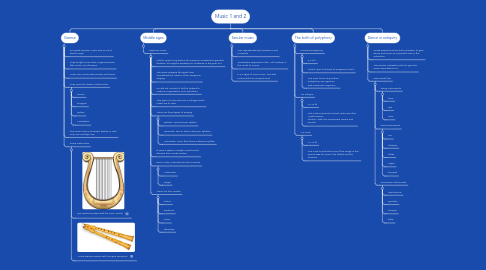
1. Greece
1.1. For greek people, music was an art of divine origin
1.2. They tougth music have magical powers that could cure illnesees
1.3. Music also comes with poetry and dance
1.4. They used four basic modal scales
1.4.1. Dorian
1.4.2. Phrygian
1.4.3. Lydian
1.4.4. Mixolydian
1.5. This music have a monodic texture in with only one melodyc line
1.6. Some instuments
1.6.1. Lyre (Relaccionated with the God Apollo)
1.6.2. Aulos (Relaccionated with the god Dionysus)
2. Middle ages
2.1. Regilious music
2.1.1. Strat to grow, long before the emperor Constantine granted freedom of religious workship for christians in the year 313
2.1.2. The pope Gregory the great, was considered the creator of the Gregorian singing
2.1.3. He did not inveted it, but he helped to make an organization and unification
2.1.4. This type of music was use in liturgys which make use of Latin
2.1.5. There are three types of singnig
2.1.5.1. Syllabic, one tone per syllabe
2.1.5.2. Neumatic, two or three notes por syllabes
2.1.5.3. Melismatic, more than three notes per syllabe
2.1.6. It used a system of eigth modal scales derived from Greek modes
2.1.7. Each mode is divided into two versions
2.1.7.1. Authenthic
2.1.7.2. Plagal
2.1.8. There are four modes
2.1.8.1. Protus
2.1.8.2. Deuterus
2.1.8.3. Titrus
2.1.8.4. Tetrardos
3. Secular music
3.1. Was represented by troubadors and ministrels
3.2. Troubadors appeared in the 11th century, in the south of France
3.3. It is a type of vocal music but with instrumental accompaniment
4. The birth of polyphony
4.1. Primitive polyphony
4.1.1. 9-12 th
4.1.2. Is built upon the base of Gregorian chant
4.1.3. The main forms of primitive polyphony are organum and melismatic organum
4.2. Ars antigua
4.2.1. 12-13 th
4.2.2. The most important musical centre was the “Notre Dame School”, with the composers Leonin and Perotin
4.3. Ars nova
4.3.1. 13-14 th
4.3.2. The most important forms of the songs in this period was de canon, the ballad and the chanson.
5. Dance in antiquity
5.1. Greek people was the first civilization to give dance and music an important role in the education.
5.2. The Roman civilization did not give the same importance to it
5.3. instruments like
5.3.1. string instruments
5.3.1.1. harp
5.3.1.2. lyre
5.3.1.3. viola
5.3.2. wind instruments
5.3.2.1. orn
5.3.2.2. dulzaina
5.3.2.3. flutes
5.3.2.4. organ
5.3.2.5. trumpet
5.3.3. percussion instruments
5.3.3.1. hand drums
5.3.3.2. cymbals
5.3.3.3. triangle
5.3.3.4. bells
